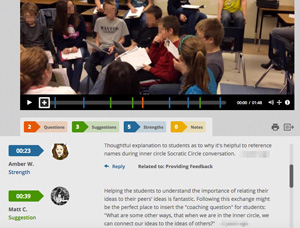 At Ruth Fox Elementary School in North Branch, MI, my colleagues and I are entering year three of our online professional learning with Matt Copeland, author of Socratic Circles. Not only have we continued our long distance learning via video, but we have also started exploring the benefits of using video to reflect on our instructional practices in the classroom. The results have been overwhelmingly positive!
At Ruth Fox Elementary School in North Branch, MI, my colleagues and I are entering year three of our online professional learning with Matt Copeland, author of Socratic Circles. Not only have we continued our long distance learning via video, but we have also started exploring the benefits of using video to reflect on our instructional practices in the classroom. The results have been overwhelmingly positive!
Just last month, Edutopia published this piece by Mary Davenport, outlining the importance of yearlong, embedded planning for successful implementation of Socratic Circles, a protocol for facilitating student-led discussions that focus on close reading, higher order thinking, question formation, and speaking and listening. Davenport’s last step, “Let’s get reflective,” is crucial for building our capacity as educators to facilitate this type of classroom dialogue to spur learning and a deep sense of community and collaboration in the classroom. How might classroom video be leveraged to provide rich opportunities for such reflection?
Lights, camera, action!
Last spring, we used smartphones and tablets to record Socratic Circle lessons in our classrooms. Next, we used a simplified version of discourse analysis to gather and analyze data about the dialogue we were facilitating among students. To begin, we selected a short segment of video, approximately five minutes, and took the time to transcribe all of the conversation that took place therein. Then, with videos and transcripts in hand, we poured over our data, tabulating and commenting on what we saw.
For example, one teacher was able to document that in her five-minute snippet of classroom dialogue:
- 89% of the verbal contributions to the conversation were made by students
- Of the 14 students in the inner circle, 10 contributed to the discussion
- Of the 18 verbal contributions, five were questions and three of those questions came from the teacher whereas only two came from students
- In 12 of the 16 student contributions, the student speaking was responding directly to another student
- There were no instances of students inviting/drawing others into the conversation
Benefits of looking through the lens
Through these video analyses, we reflected on our own practice, just as Davenport suggests we should. Exploring a range of video annotation tools (MoocNote, Video Ant, Edthena), we identified, individually, where we believed our facilitation was working well and also where there were opportunities for personal growth. Because these annotations were all documented in the technologies we were using, we were able to share our videos and analyses with one another, collaborate, and offer our own coaching tips to build one another’s capacity to facilitate better classroom dialogue in the future.
As an example, from the previous data,the teacher was able to quickly identify the strength of the verbal interactions among her students’ dialogue but then also begin to brainstorm with her colleagues strategies she might use to facilitate students generating and posing more questions to the group. The professional conversation that grew organically from this activity was every bit as rich and productive as the student-led dialogue in the classroom.
Using video and discourse analysis afforded our teachers the opportunity to step back from the details of each classroom conversation itself and weigh the breadth and depth of the dialogue against our goals for the discussion. This practice and reflection has taken our implementation of the protocol to a whole new level. Our planning for future Socratic Circles with students has been greatly strengthened by this job-embedded professional learning facilitated by video.
This fall, we intend to share these same tools and procedures with our students, to engage them in studying their own conversations through discourse analysis and video, and facilitating their own growth in learning.

 Amber White is a reading specialist, a teacher consultant for the Saginaw Bay Writing Project, and the Director of Curriculum & Instruction for North Branch Area Schools. You can reach her on Twitter. Matt Copeland is an author, presenter, and instructional coach who works with educators to build capacity in using Socratic Circles in K–12 classrooms and beyond. You can learn more about implementing Socratic Circles by joining our professional community.
Amber White is a reading specialist, a teacher consultant for the Saginaw Bay Writing Project, and the Director of Curriculum & Instruction for North Branch Area Schools. You can reach her on Twitter. Matt Copeland is an author, presenter, and instructional coach who works with educators to build capacity in using Socratic Circles in K–12 classrooms and beyond. You can learn more about implementing Socratic Circles by joining our professional community.
This article is part of a series from the Technology in Literacy Education Special Interest Group (TILE-SIG).